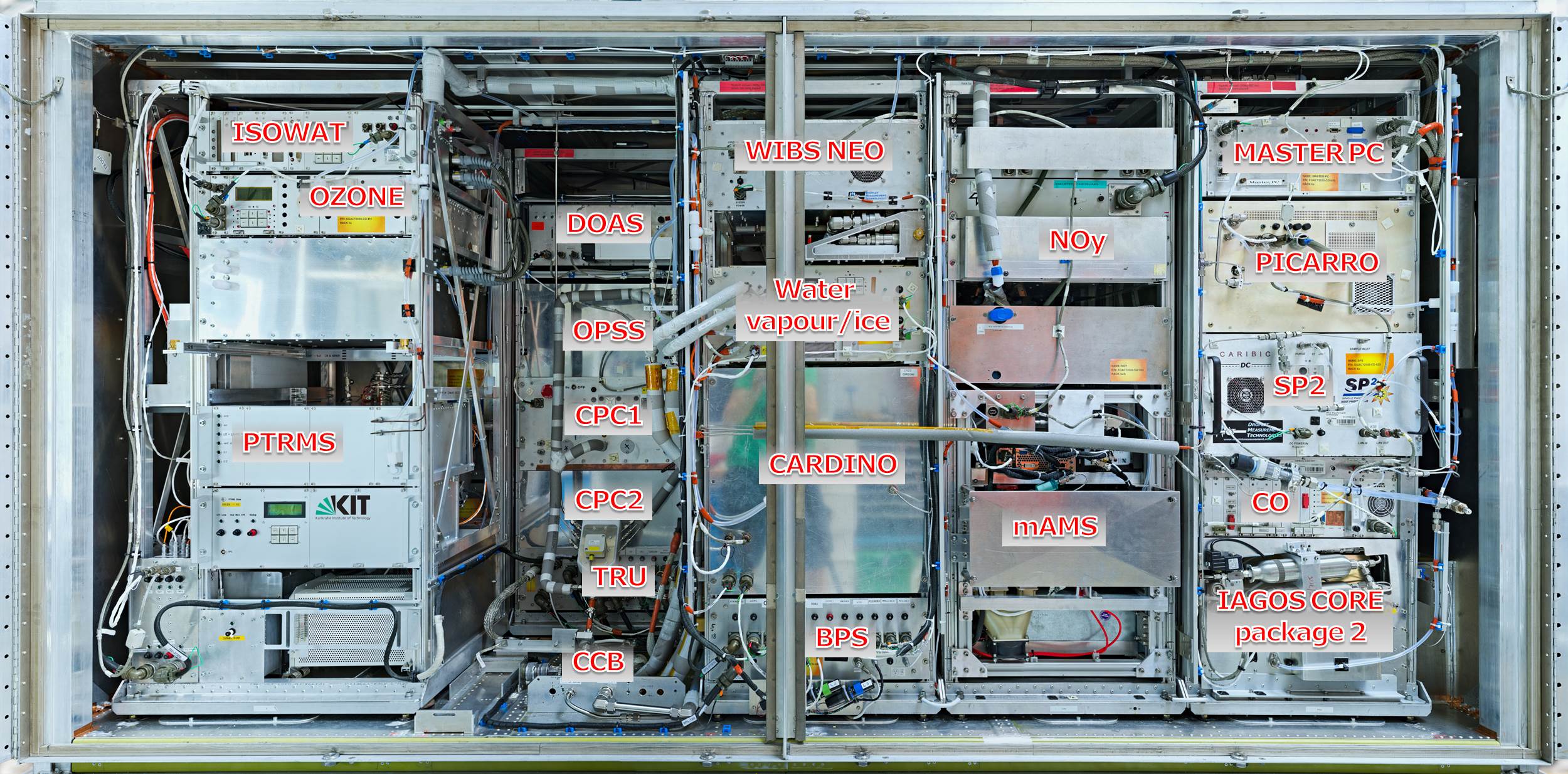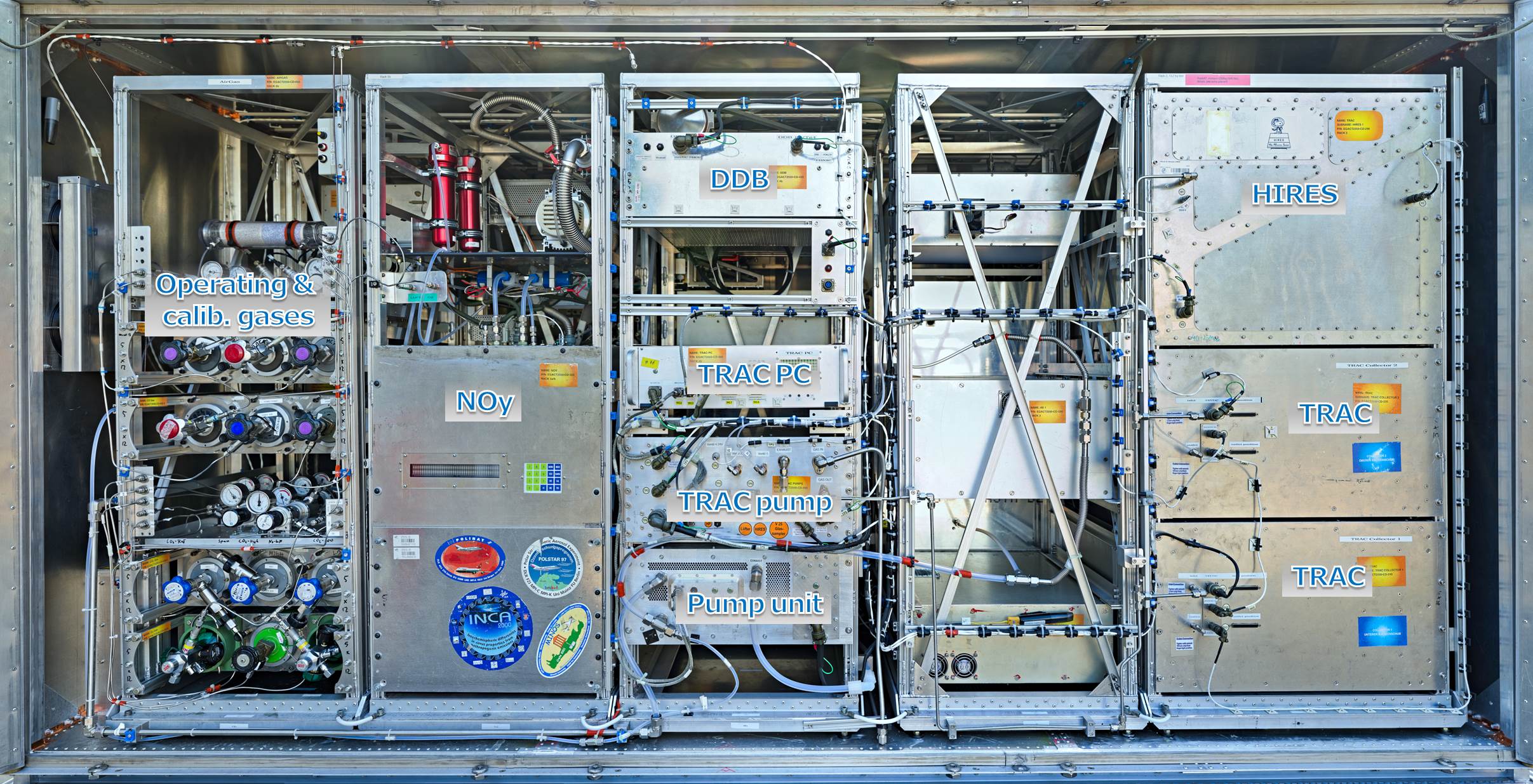The IAGOS-CARIBIC 2 Laboratory
↵A strongly modified LD11 airfreight container with finally 19 instruments in 9 racks was operated on board a Airbus A340-600 by Lufthansa airlines. The total weight was 1.6 t (including the laboratory infrastructure with e.g. master/control computer, gas rack, central power unit, etc. Driven by the Corona pandemic Lufthansa phased-out the A340-600.
Laboratory Frontside

Laboratory Backside

| Instrument | Short Description |
|---|---|
| ISOWAT | A diode-laser spectrometer to measure the D/H and 18O/16O isotope ratios of water vapor. It is connected to the total water inlet. ISOWAT uses an RT laser diode (2.64 µm), a multi-pass cell (giving 40 meter) at 60 hPa and 40 °C, a reference cell at to stabilize laser wavelength, and a background detector. |
| PTRMS | The proton transfer reaction mass spectrometer (IONICON) measures mainly acetone, methanol, and acetonitril (CH3CN). Calibration is done via a permeation source. |
| DOAS (Differential Optical Absorption Spectroscopy) | contains 3 thermoelectrically chilled UV-VIS spectrometers, that are connected via 3 silica, 6 fiber, optical cables to the 3 mini-telescopes in the inlet system measuring SO2, BrO, HONO and NO2. Each month thousands of spectra are recorded. |
| OPSS | is an optical particle size spectrometer. Species measured: Particle size distribution (0.14 μm < dp < 1.05 μm) and derived particle number, surface, volume, and mass concentrations. |
| CPC 1 | The Condensation Particle Counter unit contains 2 CPCs (TSI Model 7610) with butanol as fluid. Measured is the integral particle number concentration for particles larger than 4 and 12 nm. |
| CPC 2 and particle sampler | This condensation particle unit contains the third CPC having a lower limit of 18 nm and the aerosol particle sampler. The impactor based sampler has a cyclone separator to reject particles over 2 micron diameter. The impactor does not capture particles below 80 nm. There are 16 chambers with 3 impactors. The major impactor samples are subjected to PIXE and PESA giving detailed elemental composition from hydrogen onwards. The minor samples are for mainly electron microscopy. |
| TRU (Power Supply 1) | is activated while the aircraft is above take-off and landing conditions. Most equipment is activated only at pressures below 500 hPa to reduce risk of contamination. |
| CCB (aircraft-container interface) | Here all cables for data, light, power, electronics, air outlet, inlets, are connected. The container is installed by Lufthansa technicians within 20 minutes using extensive check lists. |
| WIBS-NEO | The WIBS-NEO from DMT delivers accurate and temporally highly resolved measurements of the number and shape of biological aerosol particles. |
| Ozone OMCAL | This lab-built compact high accuracy and precision uv absorption spectrometer also serves as in-flight calibration unit. |
| Ozone OSCAR | This lab-built unit is very fast using chemiluminiscence on a small disk with a dye. |
| Mercury | Total reactive mercury is alternatingly captured in two adsorption tubes on gold followed by its detection using atomic absorption photospectrometry and mercury lamp light (Tekran). |
| Water vapor and ice | The total water vapor inlet is connected to a photo-acoustic analyzer and a Buck frost-point hygrometer. The photo-acoustic system is fast, the hygrometer is precise and accurate. |
| Water vapor | The gaseous water vapor inlet is connected to a second photo-acoustic detector. By using both water detection systems, cloud water and super-saturation can be measured. |
| BPS (Power Supply 2) | This power supply is switched on earliest and switched of latest. It has a limited capacity for only the most essential functions when the aircraft is not cruising. |
| NO, NO2, NOy | The latest addition to this lab-built system is a photolysis cell based on UV diodes. Used are two Ecophysics NO detectors, ozone is made using oxygen, and hydrogen gas is used to reduce NOy on a gold catalyst. |
| mAMS | The mAMS is based on a commerially available mini Aerosol Mass Sprectrometer from the company Aerodyne Research Inc. |
| Master-PC | controls all equipment via an ethernetnetworks. It records the aircraft's ARINC 428 flight parameters, including pressures, temperatures, and video picture frames. |
| SP2 | Single Particle Soot Photometer SP2. |
| Carbon monoxide | is detected by VUV fluorescence (Aerolaser). |
| PICARRO | The greenhouse gas measuring device is based on the model G1301-m from the company Picarro Inc. using Cavity Ring-Down Sprectroscopy (CRDS) to measure mixing ratios of CO2, CH4 and water vapour. |
|
IAGOS-CORE package 2 |
Instruments used on IAGOS-CORE aircrafts can be tested in the IAGOS CARIBIC container. This can be done by simple adaptations. Currently four different package 2 instruments are available: P2a measures NOy by means of a gold converter and chemiluminescence P2b measures NOx by means of a photolytic converter and chemiluminescence P2c measures the aerosol size distribution with a SKY-OPC and particle concentration using two CPCs P2d uses Cavity Ring-Down method to measure greenhouse gases (CO2, CO, H2O and CH4) |
| Calibration and operating gases | 12 pressure bottles located in a separate rack. The supplies must last for over 40 flight hours (30,000 km). |
| The Data Distribution Box | is the interface between the aircraft and the container for data, temperature data and regulators. |
| The pumping unit | for TRAC and HIRES uses 2 dual stage metal bellows pumps. The first stage in parallel, the subsequent stage in series. |
| The general purpose pump unit | pumps air through various analyzers, namely CPCs and CO. |
| Air sampler HIRES | This High Resolution sampler contains 88 light weight stainless steel 1 liter flasks, wall thickness 0.25 mm, filled to nominally 4 bar. Air is purged 8 times by pressurizing and bleeding. HIRES samples are presently analyzed for greenhouse gases and nmhc. |
| Air sampler TRAC 1 and 2 | This system contains 2 units of 14 2.7 liter glass flasks filled to nominally 4bar. Air is purged by flushing. The glass flasks allow for accurate isotope analyses of CO2 (no 18O exchange) and are routinely analyzed for greenhouse gases, nmhc, and halocarbons. Three pair of units allows for turn-over time for all analyses in 3 laboratories. |
| Ventilation systems | displace large amounts of air (at about 850 hPa) to carry away heat and to even out temperature differences. The cargo bay is cooled via the aircraft's air conditioning system. |
